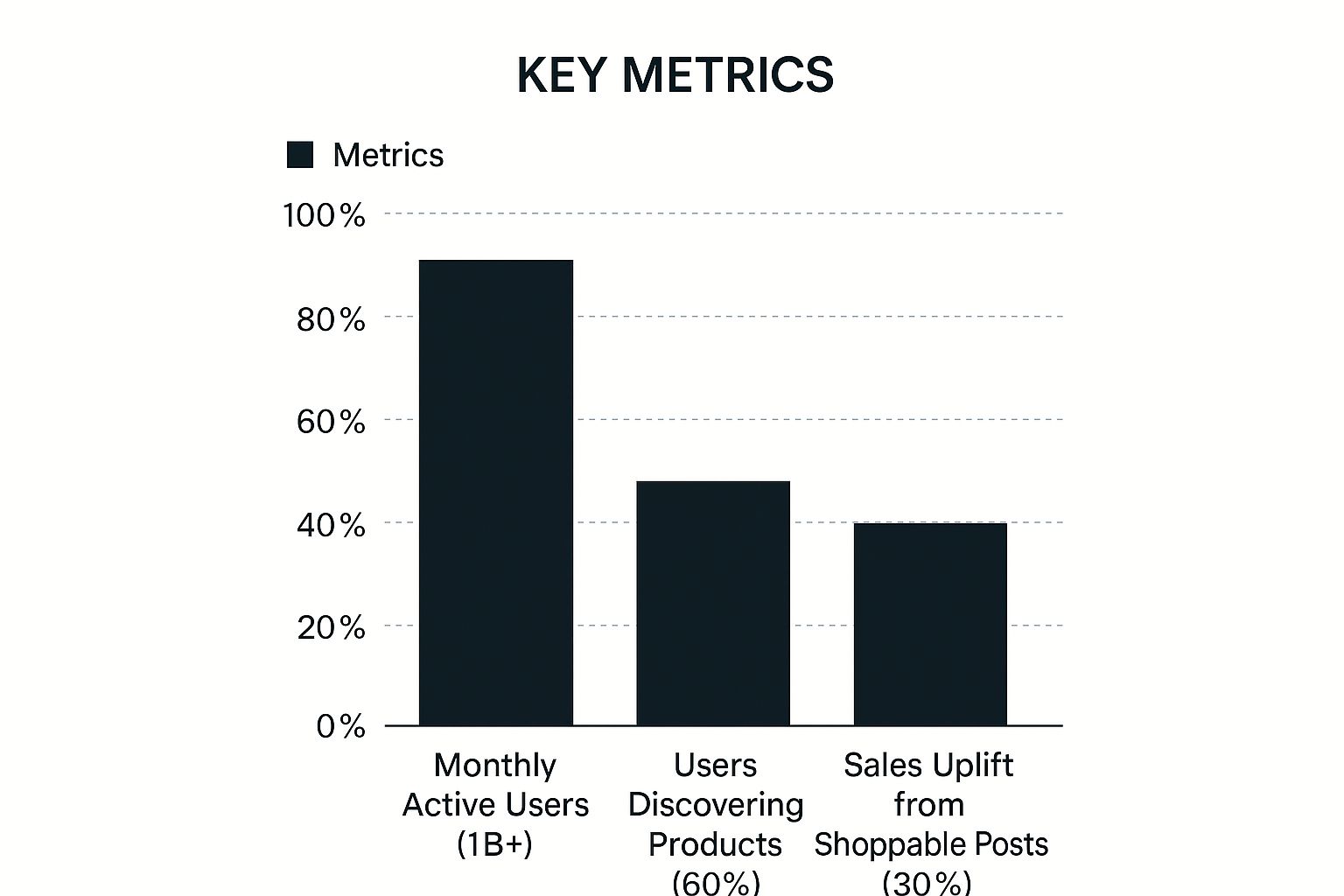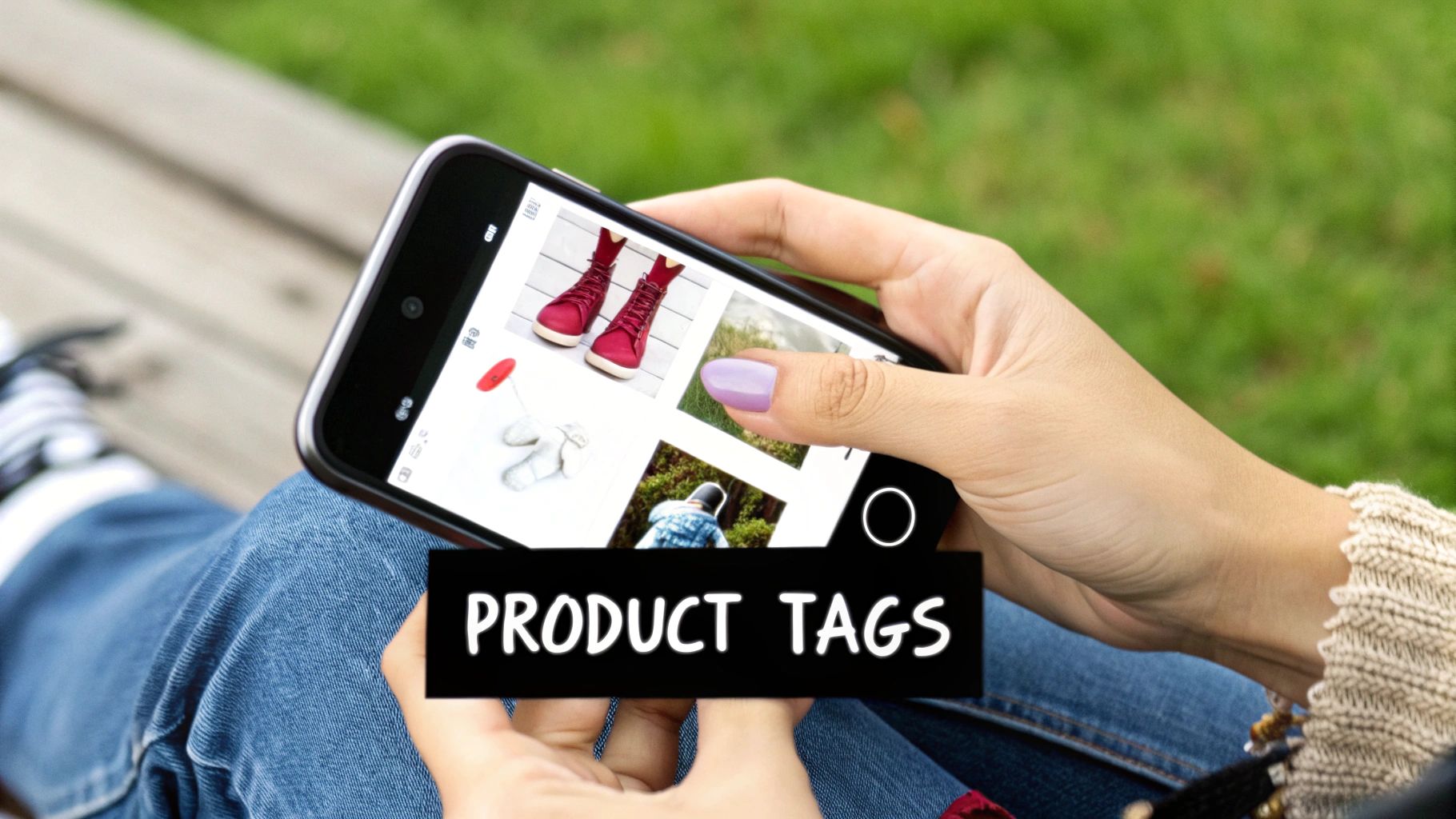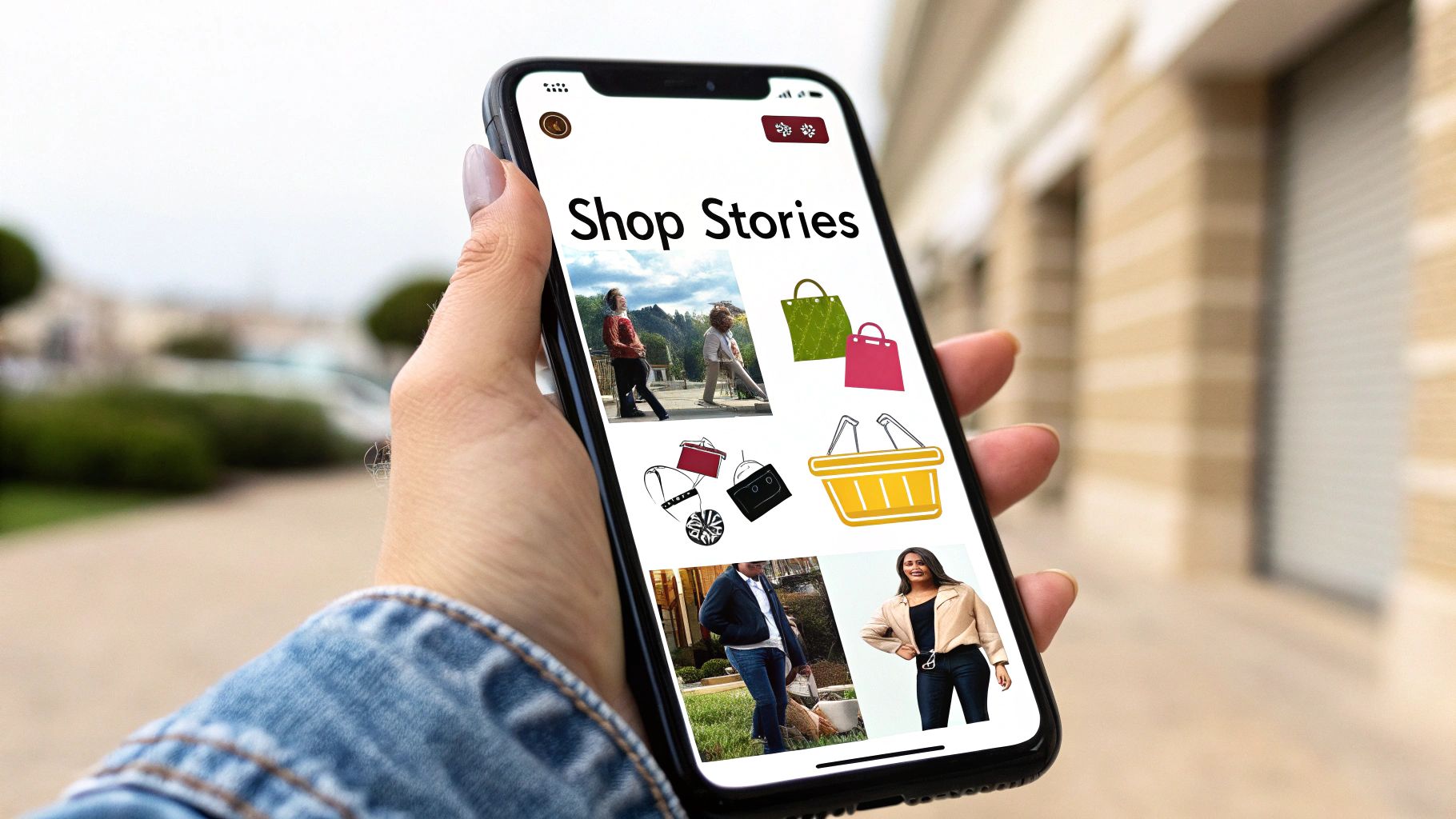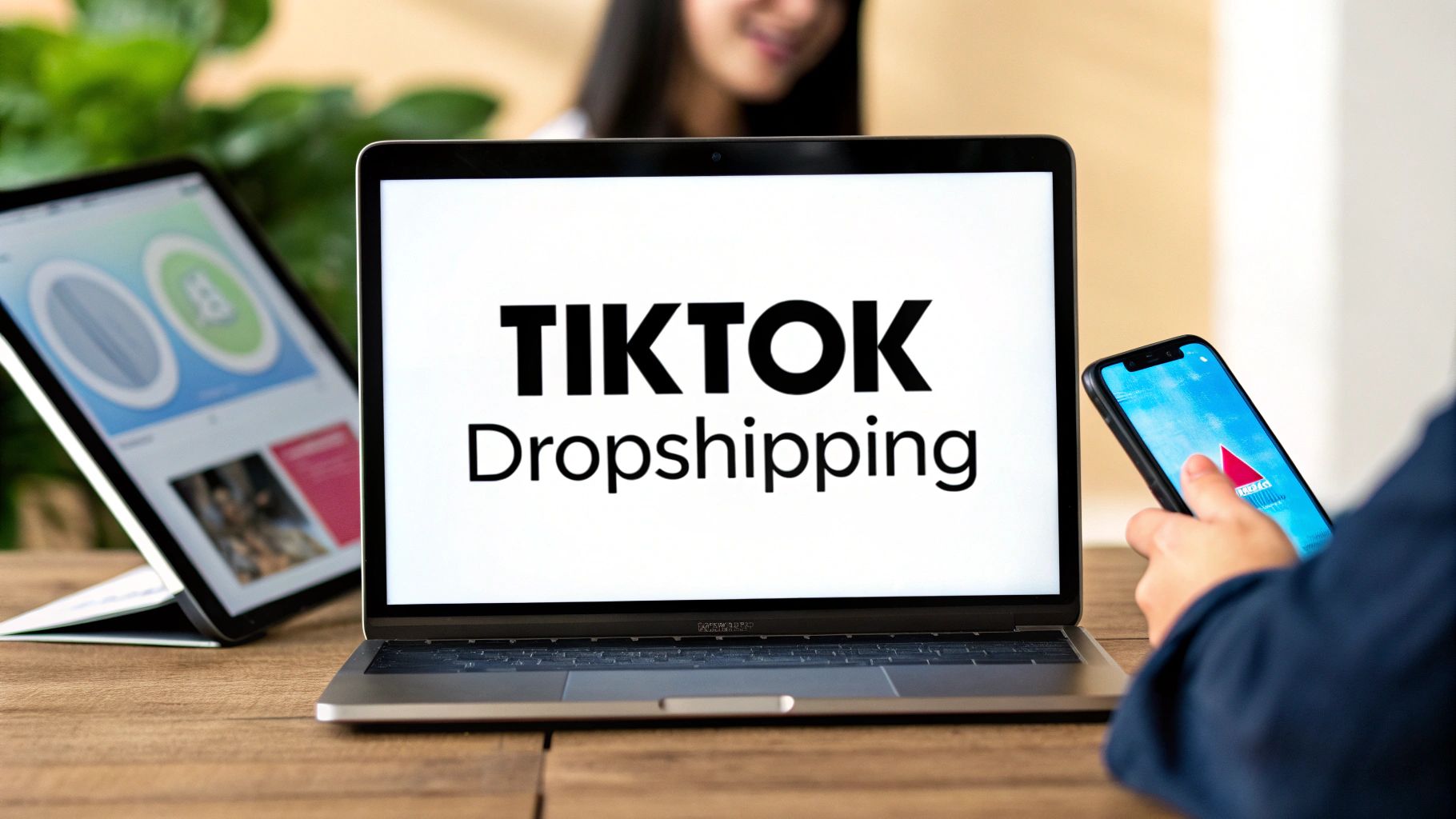Make Instagram Shoppable: 3 Steps to Transform Your Profile
May 25, 2025

The Instagram Shopping Revolution: What's Really Possible
Instagram has quickly become more than a place to share photos. It's now a thriving marketplace. But what does this mean for businesses? It means access to a huge audience actively looking for products and inspiration. It also means knowing how to use Instagram's features to turn casual browsers into paying customers.
The Power of Shoppable Instagram
Instagram’s potential as a sales channel is enormous. The infographic below highlights some key statistics:

This data shows the platform’s impressive reach, with over 1 billion monthly active users. It also demonstrates the high purchase intent of its users, with 60% discovering products on the platform. Shoppable posts can lead to a 30% increase in sales. Learn more about creating effective shoppable content: How to master shoppable content.
Instagram's growth as a shopping platform is remarkable. As of 2025, 29% of Instagram users make purchases directly through the app. This makes it a major player in social commerce and the third-most-used platform for shopping.
With over 2.11 billion monthly active users, Instagram presents a significant opportunity. Interestingly, 70% of these users are under 34, a key demographic for many brands. Instagram Stats offer a deeper dive into these numbers.
From Browsing to Buying: The Instagram Advantage
Why are so many people buying on Instagram? The platform's visual nature is perfect for product discovery. Users are already engaging with images and videos, making it easy for businesses to showcase products attractively.
Features like product tagging, shoppable posts, and the Shop Tab create a seamless buying experience. Users can purchase directly within the app. This streamlined process reduces friction and encourages impulse buys. But simply setting up a shop isn’t enough.
Maximizing Your Shoppable Potential
Driving the right kind of traffic to your shoppable content requires a solid grasp of Instagram advertising. The Instagram Ads Guide offers a comprehensive overview.
Create engaging content that tells a story and connects with your audience. Don’t just showcase products. Learn to leverage all of Instagram's shopping features. This includes everything from product tags in posts and Stories to live shopping.
By strategically combining compelling content, effective tagging, and targeted ads, businesses can unlock Instagram's full potential.
The following table summarizes the key differences and similarities between Instagram shopping and traditional e-commerce platforms.
Instagram Shopping vs. Traditional E-commerce
| Feature/Metric | Instagram Shopping | Traditional E-commerce Platforms |
|---|---|---|
| Discoverability | Primarily visual, driven by exploration and influencer marketing | Relies on SEO, paid advertising, and website navigation |
| User Experience | Seamless, in-app purchases | Can be less integrated, requiring redirects to external websites |
| Target Audience | Younger demographic, active on social media | Broader audience, including those less active on social media |
| Cost | Lower barrier to entry, potential for organic reach | Higher setup and maintenance costs, requires investment in marketing and advertising |
| Control | Limited customization options compared to owning a website | Full control over website design, functionality, and branding |
| Analytics | Instagram provides insights on reach and engagement | More comprehensive analytics platforms available for tracking website traffic and sales |
This table highlights that while Instagram shopping excels in discoverability and user experience for a younger demographic, traditional e-commerce platforms offer greater control and more in-depth analytics. Choosing the right platform depends on your specific business goals and target audience.
Setting Up Your Shoppable Instagram: What They Don't Tell You
So, you're ready to turn your Instagram presence into a sales powerhouse? You've probably seen the basic setup guides, but they often miss the key details that separate successful Instagram shops from the rest. This section dives into the often-overlooked aspects of setting up shop on Instagram, using insights from successful merchants.
Navigating the Approval Process
Getting approved for Instagram Shopping isn't always easy. The official guidelines outline the requirements, but the reality can be more complex. Many sellers get stuck in the review process, often due to seemingly small issues. One common problem is incomplete product information in your catalog. Make sure every product has a detailed description, high-quality images, and the correct price. Also, double-check that your business profile follows Instagram's commerce policies. For more information, check out this helpful guide: How to sell on Instagram with Shopify.
Structuring Your Product Catalog for Success
Your Instagram product catalog is your online storefront. How you organize it directly impacts how easily customers find your products and how much they buy. Instead of just listing everything, create Collections. Grouping similar items together makes browsing simpler and can lead to more sales. For example, a clothing store could create collections like "Summer Dresses," "Workwear Essentials," or "New Arrivals." This helps customers quickly find what they want.
Avoiding Common Technical Pitfalls
Setting up an Instagram shop can sometimes involve technical difficulties. One frequent issue is syncing problems between the product catalog and the Instagram shop. This can result in products not showing up correctly or being unavailable. Regularly check your catalog for errors and make sure it’s properly connected to your Instagram account. Using a platform like Shopify can simplify this process and prevent many of these issues. Many businesses now use Shopify to sell courses. Be sure to explore the various online course platforms, including how to Sell Courses On Shopify.
Adapting to Different Business Models
Your approach to Instagram Shopping should fit your business model. A direct-to-consumer brand might focus on showcasing their story and unique product features. A retailer might concentrate on curated collections and promotions. A service business could use shoppable posts for booking appointments or consultations. Understanding these differences is key to success.

The Financial Impact of Instagram Shopping
The financial benefits of using Instagram's shoppable features are significant. The platform contributes $40 billion to global e-commerce sales each year. This shows how much Instagram influences buying decisions and its importance as a sales channel. Plus, over 130 million users click on shopping posts every month. This creates a huge opportunity for businesses to connect with customers and increase sales. For more statistics, see this resource.
The Art & Science of Product Tagging That Converts
Product tagging on Instagram is much more than simply adding a link to an image. It's a powerful strategy for turning interest into sales. What makes some tagged content convert better than others? It’s a combination of visual appeal and a deep understanding of user behavior. This section explores the nuances of product tagging on Instagram to help you maximize your conversions.
Placement, Density, and Composition
Accurate tag placement is essential. Imagine trying to find a product tagged in the background of a busy image. Frustrating, isn't it? Place tags directly on the products themselves. This allows users to quickly identify and learn more about the item.
Tag density is also important. Too many tags can overwhelm users. While offering options is good, avoid cluttering the image. The right balance creates a seamless and enjoyable shopping experience. Think of it like arranging furniture: too much in a small space feels cramped, while too little feels empty. The right tag density creates the perfect "flow" for your shoppable post.
The visual composition of your image plays a vital role. High-quality product photos with good styling and lighting capture attention. Showing products in context, like lifestyle shots, adds depth and makes them relatable. Instead of just showing a handbag against a white background, picture someone using it during a day out. This visual storytelling draws customers in, creating a stronger connection with your product.
Psychology and User Experience
Understanding online shopping psychology is essential for making Instagram shoppable. Product tags shouldn’t interrupt the user experience; they should enhance it. Seamless integration is the key. Think of product tags as helpful guides, gently directing customers toward more information and purchase options.
Subtle visual cues can encourage purchases. Highlighting scarcity, like limited-edition items, creates a sense of urgency. Showcasing social proof, such as user-generated content, builds trust and inspires others to buy. These psychological nudges can significantly impact user behavior, turning passive scrolling into active shopping.
Tagging Strategies Across Verticals
Effective tagging strategies differ across industries. What works for fashion may not be effective for home goods. A fashion brand might tag multiple items in a single outfit photo. A home goods brand might tag individual items within a room setting.
Learn more about optimizing your Shopify store’s Link in Bio page with LinkShop. LinkShop, a powerful link in bio app for Shopify merchants, helps create visually appealing and shoppable bio pages. It's a tool designed to boost your Instagram shopping efforts, turning followers into customers.
Creating Content That Sells Without Looking Salesy
Making your Instagram shoppable is more than just adding products to your shop and tagging them in posts. It's about creating content that seamlessly blends commerce with genuine connection. Successful shoppable Instagram accounts know how to inspire and engage their audience while subtly guiding them toward a purchase. Let's explore the strategies for creating high-converting content that feels authentic, not pushy.
Crafting Compelling Product Stories
Think of your products as characters in a story. What makes them unique? What problems do they solve? Instead of just listing features, highlight the benefits and how they improve your customers' lives. For example, instead of "This dress is 100% cotton," try "This comfortable cotton dress is perfect for a summer picnic." This approach makes your product relatable and desirable.
Visual Storytelling Through Composition
How you visually present your products greatly influences purchasing decisions. Use high-quality images and videos showcasing your products in action. Lifestyle shots are particularly effective. Showing products in real-life situations helps customers visualize how they could use them.
Content Themes That Support Shopping
Developing consistent content themes can naturally integrate your products into your brand's story. For example, a fitness brand might focus on themes like healthy recipes, workout routines, or motivational stories. These themes create a context for showcasing fitness apparel and equipment without being overly promotional.
Optimizing Content Formats for Conversion
Different content formats perform differently when driving sales. Static images showcase product details, but videos and Reels often outperform in engagement and conversion. They offer a dynamic, immersive experience, demonstrating product use and connecting with your audience. Consider using Instagram Stories for behind-the-scenes content and Live sessions for real-time product demos. You might be interested in: How to master Instagram Link in Bio.
Content Calendar and Caption Strategies
A content calendar aligned with your shopping objectives can maximize your sales potential. Plan posts around key shopping dates like holidays or special promotions. Captions should complement your visuals and reinforce product stories. Use strong calls to action, like "Shop now" or "Link in bio," to direct your audience to your shop.
Maintaining Brand Voice While Selling
While optimizing for commerce is important, don't lose your brand's unique personality. Authenticity is key on Instagram. Content should always reflect your brand voice, even when showcasing products. This means using a consistent tone and style across all posts, regardless of whether they're directly shoppable.
The following table shows how different content formats perform on Instagram Shopping. This data offers a general overview of average engagement and conversion rates.
Content Performance by Format for Instagram Shopping
| Content Format | Average Engagement Rate | Conversion Rate | Best For |
|---|---|---|---|
| Image Posts | Moderate | Moderate | Showcasing product details and styling |
| Video Posts/Reels | High | High | Demonstrating product use and engaging storytelling |
| Stories | High | Moderate | Behind-the-scenes content and quick promotions |
| Live Shopping | High | High | Real-time product demonstrations and interactive Q&A |

By mastering these techniques, you can create shoppable content that resonates with your audience, drives sales, and strengthens your brand identity. This approach ensures your content feels authentic and engaging, not just a sales pitch.
Beyond Basic Posts: Maximizing Every Shopping Touchpoint
Successfully selling on Instagram means thinking beyond simply tagging products in your feed posts. Smart Instagram sellers understand the importance of offering various ways for customers to shop. They use the full range of Instagram's features to create a dynamic and engaging experience. This connects with customers at different stages of their buying journey.
Leveraging Stories, Reels, and Live Shopping
Instagram Stories, Reels, and Live sessions provide unique ways to connect with your audience and boost sales. Stories, which disappear after 24 hours, create a sense of urgency – perfect for flash sales and limited-time offers. Reels, with their short, catchy video format, showcase products in action, grabbing attention and sending shoppers to your store. For example, a clothing brand could create a Reel featuring a new outfit, tagging each item for easy purchase. Live shopping lets you chat with customers in real-time, answering questions and demonstrating products for a more personal experience.
The Power of the Shop Tab
The Instagram Shop Tab is like having your own storefront within your profile. It’s a central hub where you can arrange your products into collections, making browsing easy for customers. Imagine a bookstore organizing its Shop Tab by genre – thrillers, romance, sci-fi. This helps customers quickly find what they want. This streamlined experience makes shopping easier and encourages customers to explore more.
Integrating Shopping Across Features
Integrating shopping across different Instagram features creates a smooth and engaging experience. Think of it like a well-designed retail store. Just like a physical store uses displays, signs, and helpful staff, your Instagram presence should seamlessly integrate shopping options. This gives customers multiple ways to discover and purchase your products. Learn more in our article about How to master Shopify Social Media integration.
Optimizing for Conversions: Timing, Content, and Integration
Each Instagram format needs a specific approach to maximize sales. Understanding these nuances is key. Stories are ideal for short, captivating clips, while Reels allow for more detailed product demonstrations. When you post also makes a difference. Sharing Stories during peak activity times can significantly boost visibility. Think about the type of content and how it fits within each feature to create the most effective shopping journey.

Strategic Implementation for Different Products and Price Points
Not all shopping features are equally effective for every type of product. Expensive items might benefit from a more in-depth presentation in Reels or Live sessions, while budget-friendly products could be promoted through quick, engaging Stories. For instance, a jewelry brand might use a Live session to highlight a high-end necklace's details, while a t-shirt company might use Stories for a flash sale. Understanding these differences allows you to adjust your strategy for the best results. By strategically using all of Instagram's shopping features, you can turn your profile into a dynamic sales engine, connecting with potential customers at every point.
Driving Qualified Traffic to Your Shoppable Content
Creating compelling shoppable content is only the first step. Even the most visually appealing Instagram Reels or perfectly tagged products won't boost sales if your target audience doesn't see them. This section explores how to attract the right audience—those ready to make a purchase—to your shoppable Instagram content. We'll cover both organic and paid strategies successful merchants use to expand their reach and drive conversions.
Organic Strategies for Shopping-Focused Audience Growth
Organic reach on Instagram hinges on building authentic connections with your target audience. This means crafting valuable content that truly resonates with their interests and needs. For instance, a sustainable fashion brand might share tips on creating an eco-friendly wardrobe, featuring their products within these helpful posts. This approach attracts an audience already interested in sustainable living, making them more likely to become customers.
Key Organic Tactics:
-
Hashtag Strategy: Relevant hashtags help your shoppable content appear in searches, expanding your reach. Go beyond generic hashtags. Use niche-specific hashtags that target shoppers actively looking for products like yours. Instead of just #fashion, consider adding #ethicalfashion or #slowfashion.
-
Engaging Content: Consistently posting high-quality, engaging content is essential. This includes a mix of product showcases, lifestyle images, behind-the-scenes looks, and user-generated content. A diverse content strategy keeps your audience interested and encourages them to return.
-
Community Building: Engage with your followers! Respond to comments, answer questions, and participate in relevant discussions. A strong community builds trust and loyalty, converting followers into customers. For more tips, check out our guide on How to master promoting your Shopify store.
Paid Strategies for Targeted Reach and Conversions
While organic strategies are fundamental, paid advertising can significantly boost your reach and direct targeted traffic to your shoppable posts. Instagram offers various ad formats specifically designed for shopping, allowing you to connect with potential customers based on demographics, interests, and even past buying behavior. This targeted approach maximizes your return on investment by focusing on the most promising leads.
Effective Paid Tactics:
-
Shoppable Ads: Develop ads specifically to highlight your products, using attractive visuals and clear calls to action. These ads can appear in users' feeds and Stories, directly linking to your product pages.
-
Retargeting Campaigns: Retargeting ads re-engage users who have previously interacted with your content or products. This personalized strategy increases the likelihood of converting those who have already shown interest.
-
Influencer Marketing: Collaborating with relevant influencers can introduce your brand to a new audience and build credibility. Select influencers whose followers align with your target market for the greatest impact.
Identifying High-Converting Traffic Sources
Analyzing your traffic sources is crucial for understanding which strategies are effective. Monitor metrics like click-through rates, conversion rates, and average order value. This data reveals which strategies are attracting the most qualified traffic—those who are actually making purchases. If, for example, your Reels generate a higher conversion rate than your feed posts, prioritize creating more Reels.
By combining organic and paid strategies, you can effectively drive qualified traffic to your shoppable Instagram content. Focus on cultivating a loyal following while also utilizing targeted ads to reach new potential customers. The key is to create a seamless and enjoyable shopping experience that guides users from discovery to purchase.
Ready to elevate your Instagram into a powerful sales channel? LinkShop, a link in bio app designed for Shopify merchants, helps you create attractive, shoppable link in bio pages. It offers a more robust alternative to Linkpop, designed to convert followers into customers. Visit LinkShop today to learn more and start increasing your Instagram sales.



